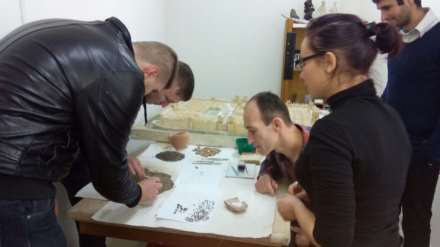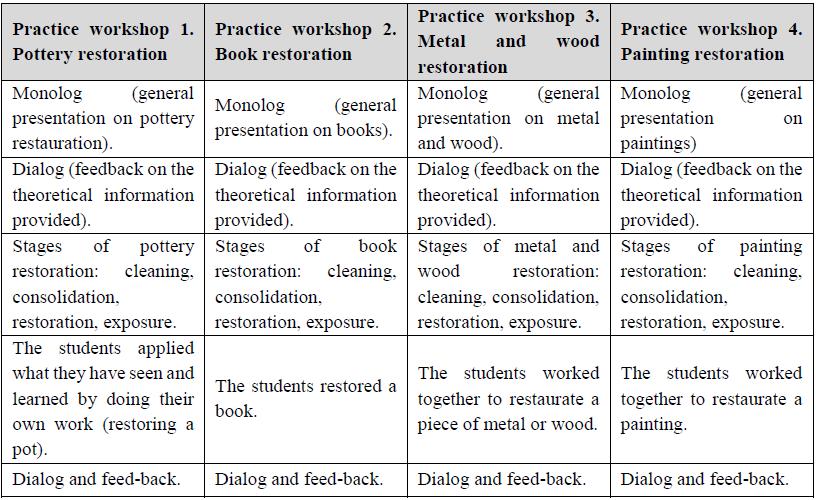Abstract
We therefore need language and ideas from many intellectual disciplines and spheres of action to broaden our view of the educational process, to see more and more clearly, and thus achieve more and benefit more. The topic approached is seen as a useful alternative to current education training in the university environment. This is meant to highlight the benefits of the type of debate, the notions and concepts experienced in these actions, illustrated by clear examples of their deployment in museums (for example, some activities of this kind will be presented from the Argeş County Museum). The applicability, the usefulness of information acquired by students during the training sessions will find a correspondent in the non-formal activities of museums, increasing the plurality of individual involvement in the learning activity. Non-formal education conducted in this way should be perceived as an ideal feedback solution between the two poles (professor and student). Museums that practice discovery learning have exhibitions and/or uses museum specialists that allow the exploration and do not require a specific path, are an opened field of new discoveries for students. Interactive adult workshops are also a good practice in this type of museums.
Keywords: Historymuseumteachingtrainingpracticeproject
Introduction
The main purpose of a museum in contemporary society, apart from research and preservation, is
education. A museum is throughout his expositions a place that offers to visitors a great quantity of
information on certain fields and research areas in a very accessible way (Cebanu, 2014). Nonformal
educational programs can influence an individual more than institutions like schools, by enriching
knowledge, generating a feeling of respect and admiration towards science a knowledge (Coombs, 1968).
In time, nonformal education was given a big number of definitions that in essence can be summarized as:
the ensemble of pedagogical actions that are focused and related in an extra disciplinary institutionalized
framework(Cristea, 2000). A good example of the implementation of the dialogue between the institutions
can be found in the project "Internships - a prerequisite for professional success", co-financed from the
SOCIAL EUROPEAN FUND through the Sectorial Operational Program Human Resources Development
2007-2013. Since 2014, the project is runned an implemented by University of Pitesti, based on the
financing agreement concluded with POSDRU, in partnership with the Argeș Businessmen Association.
The project aims to: develop students' work skills by increasing their employment opportunities and
successfully integrating them into the labour market, an objective that will be achieved by increasing the
training in their field of study (500 students of higher education in the South-Muntenia); improve
counseling and career guidance services to facilitate the transition to the labour market; to develop and
valorize the cooperation between the university environment and business organizations for the
development of work learning programs (Figure

Problem Statement
The interest of universities on nonformal activities in museums could be larger. A museum can offer:
exploring educational possibilities through the study of object interpretation, mainly in the form of the
exhibit. “INVEST IN PEOPLE”, was a European project, where Arges Museum was one of the partners, a
project that started in September 2014 and ended in April 2015. The implementation of this project aimed
to facilitate the access of students of University of Pitesti in several workshops. The project steps revealed
the main field of activities in Arges Museum: restoration, preservation, archeological site research and
organisation of exhibitions. The main purpose was to organise applied workshops which leads to practical
and efficient access of students to cultural activities. The students involved gained throughout their
internships a high level of experience by working with the museum specialists in preservation, presentation
of mobile heritage (objects, bones, textiles, plants, insects, paintings, etc.). The project had a practical form
of feedback: the students had the possibility to ask direct questions to specialists in order to understand
more aspects presented during the workshop (more than they usually get in the classroom) (Cucos, 2014).
Research Questions
The main research question that is highlighted in this article is the following: how much can a student
learn from a practical approach like workshops and debates, comparing to staying in a classroom for a
seminar. We can find an answer searching for theoretical support in a simplified scheme of educational
communication such as: the transmitter, the receiver, the communication channel, the code, the
communicators' repertoires, the message, the feedback, the context in which the communication is made,
the noise that disturbs the quality of the message (Fiske, 2009). But the main element developed in this
paper is the context, as key element of communication because it always takes place in specific contexts,
in distinct circumstances that inevitably affects the course of the process and the effects it causes.
Key findings about museum specialists (curators, restorers, conservators etc) reveal that they see
themselves as facilitators of learning, encourage hands-on participation, convey a sense of fun,
knowledgeable of their speciality, and seek to actively engage participants (Banz, 2009). Although
informative, this study mostly provides a list of attributes, methods, and barriers experienced by the
mentioned specialists, and it lacks a theoretical framework to help make sense of the various phenomena
and how they relate to each other within a nonformal educational setting. Furthermore, and most
significantly, there is little appreciation of the museum nonformal education context (Taylor et al., 2008).
Purpose of the Study
The purpose of the study is to demonstrate how important a practical approach in teaching is,
according also to the projects described in the paper. Considering this statement we have established two
main hypothesis: first one is ”If teachers make a practical approach of the teaching act than students can
gain practical experience” and the second one is: ”If a Museum offers a space, experience and practical
teaching more than schools, universities can benefit from this knowledge”.
Research Methods
For this study has been used a mix of research methods such as: participative observation and content
analysis. Both methods are qualitative approaches that can help bring to surface some new ideas concerning
how can we be more effective in the educational act. The instruments used to gather information for this
research were: direct observation and data gathering form the participants of the workshops developed
during certain projects and the content analysis of the information (the answers of the participants)
(Marinescu, 2009).
Findings
Regarding our research, we have gathered important data concerning the importance of practical teaching
and practical methods and approaches in teaching. The students involved in this workshops have stated that
”It has been a huge experience for me, to do my own pottery restoration” or “to restaurate this book”…
“metal, wood or painting”….”to transform a piece of pottery that looks like a brick into a pot that will be
exposed in a museum exhibition”. Furthermore all the students considered that the dialogue-practice
method used during workshops, it was an amazing teaching act (Table 01).

Conclusion
According to Taylor, “the practice of didactic expository education is normally organized
sequentially and it uses didactic components of written labels to achieve specific objectives in museum,
and all this is in the benefit of the subjects of education. Museums that practice discovery learning have
exhibitions and/or uses museum specialists that allow the exploration and do not require a specific path, are
an opened field of new discoveries for students. Interactive adult workshops are also a good practice in this
type of museums.
In the same direction goes constructivist learning, which encourages participants to construct their
own meaning of the museum experience (Taylor et al., 2008).
Through our research experience and findings, we understood that the university-museum
collaboration via internships it is highly valued by students which has a direct impact to their personal and
professional development, with interesting consequences to their career paths. This type of cooperation
must be supported and sustained at regional and national level by all actors involved in the process,
including the local authorities. The Triple Helix Model can be applied in this type of cooperation in order
to fulfil further expectations of both, students and labour market.
References
- Banz, R. N. Jr. (2009). Exploring the personal responsibility orientation model: self-directed learning within museum education (Doctoral dissertation). Retrieved from https://etda.libraries.psu.edu/files/final_submissions/5267 Cebanu, L. (2014). Educaţia nonformală: caracteristici, principii, forme de realizare (Non-formal education: features, principles, forms of achievement). Univers pedagogic (Pedagogical Universe), 23-28.
- Retrieved from https://ibn.idsi.md/sites/default/files/j_nr_file/revista%2BUP_1_%2B2014.pdf Coombs, P. H. (1968). The World Educational Crisis; A System Analysis. New York: Oxford University Press.
- Cristea, S. (2000). Dictionar de pedagogie [Dictionary of pedagogy]. București: Litera Internațional. Cucoş, C. (2014). Pedagogie [Pedagogy] Ed. III. Iași: Polirom.
- Fiske, J. (2009). Introducere în comunicare [Introduction to communication]. Iași: Polirom.
- Investește în oameni (Invest in people). Retrieved from http://stagiidepractica-pitesti.ro/?fbclid=IwAR3LxmgdNZzlzWKRRz1MUOqbPcQ0K0l2odHNJdF1wC9mxCfCOvyuyAv4tcMarinescu, V. (2009). Cercetarea în comunicare: metode și tehnici [Research in communication: methods and techniques]. București: C.H. Beck.
- Taylor, E. W., Neill, A. C., & Banz, R. (2008, September). Theaching In situ: nonformal museum education. The Canadian Journal for the Study of Adult Education, 21(1), 19-34. Retrieved from https://cjsae.library.dal.ca/index.php/cjsae/article/download/1095/1051/
Copyright information

This work is licensed under a Creative Commons Attribution-NonCommercial-NoDerivatives 4.0 International License.
About this article
Publication Date
15 August 2019
Article Doi
eBook ISBN
978-1-80296-066-2
Publisher
Future Academy
Volume
67
Print ISBN (optional)
-
Edition Number
1st Edition
Pages
1-2235
Subjects
Educational strategies,teacher education, educational policy, organization of education, management of education, teacher training
Cite this article as:
Pungoi, A., & Popescu*, E. (2019). The Museum As Nonformal Resource Of Practical Activities For Universities (Colleges). In E. Soare, & C. Langa (Eds.), Education Facing Contemporary World Issues, vol 67. European Proceedings of Social and Behavioural Sciences (pp. 2062-2066). Future Academy. https://doi.org/10.15405/epsbs.2019.08.03.255
